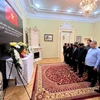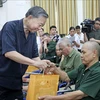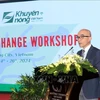Vietnam wants further global assistance to clear bomb and mine contaminated areas in the time to come, said a Vietnamese official.
Pham Quoc Tru, deputy head of the Vietnam Permanent Mission to the United Nations, the World Trade Organisation (WTO) and international organisations told a Vietnam News Agency correspondent in Geneva that Vietnam has made every effort to clear bombs and mines left from the war over the past several decades.
He said that in the wake of the 1975 Great Spring Victory, over 20 percent of Vietnam’s areas were polluted with bombs, mines and explosives. So far, nearly 4 percent of the land has been cleared.
In April 2010, the Prime Minister adopted the 2010–2025 National Action Programme on overcoming the consequences of post-war bombs and mines, and established a State Steering Board on this programme, known as Steering Board 504, which he heads himself.
The programme aims to mobilise domestic and global resources to minimise and surmount the consequences of bombs and mines, ensure the safety for people and help victims settle down their lives, he added.
In addition, Vietnam has received assistance from Japan, the US, Norway and international organisations like the Geneva International Centre for Humanitarian Demining, Golden West Foundation, Norwegian People’s Aid and Vietnam Peace Trees.
Regarding Vietnam ’s role in the Conference on Disarmament (CD), Tru said Vietnam has actively worked at CD forums since it became a member in 1996.
Vietnam has expressed its stance on disarmament, peace and security maintenance as well as other issues discussed at CD forums, he said.
Tru added that in honour of bomb and mine victims, the artwork “Broken Chair” by Swiss artist Daniel Berset was placed in front of the Palace of Nations, Geneva in August 1997, three months ahead of the signing of the Ottawa treaty, known as the Convention on the Prohibition of the Use, Stockpiling, Production and Transfer of Anti-Personnel Mines and their Destruction.
Initiated by Switzerland’s Handicap International, the monumental sculpture is made of 5.5 tonnes of wood and stands over 20 metres high. It symbolises an opposition to mines and cluster bombs, and acts as a reminder to politicians visiting the European country.-VNA
Pham Quoc Tru, deputy head of the Vietnam Permanent Mission to the United Nations, the World Trade Organisation (WTO) and international organisations told a Vietnam News Agency correspondent in Geneva that Vietnam has made every effort to clear bombs and mines left from the war over the past several decades.
He said that in the wake of the 1975 Great Spring Victory, over 20 percent of Vietnam’s areas were polluted with bombs, mines and explosives. So far, nearly 4 percent of the land has been cleared.
In April 2010, the Prime Minister adopted the 2010–2025 National Action Programme on overcoming the consequences of post-war bombs and mines, and established a State Steering Board on this programme, known as Steering Board 504, which he heads himself.
The programme aims to mobilise domestic and global resources to minimise and surmount the consequences of bombs and mines, ensure the safety for people and help victims settle down their lives, he added.
In addition, Vietnam has received assistance from Japan, the US, Norway and international organisations like the Geneva International Centre for Humanitarian Demining, Golden West Foundation, Norwegian People’s Aid and Vietnam Peace Trees.
Regarding Vietnam ’s role in the Conference on Disarmament (CD), Tru said Vietnam has actively worked at CD forums since it became a member in 1996.
Vietnam has expressed its stance on disarmament, peace and security maintenance as well as other issues discussed at CD forums, he said.
Tru added that in honour of bomb and mine victims, the artwork “Broken Chair” by Swiss artist Daniel Berset was placed in front of the Palace of Nations, Geneva in August 1997, three months ahead of the signing of the Ottawa treaty, known as the Convention on the Prohibition of the Use, Stockpiling, Production and Transfer of Anti-Personnel Mines and their Destruction.
Initiated by Switzerland’s Handicap International, the monumental sculpture is made of 5.5 tonnes of wood and stands over 20 metres high. It symbolises an opposition to mines and cluster bombs, and acts as a reminder to politicians visiting the European country.-VNA



















